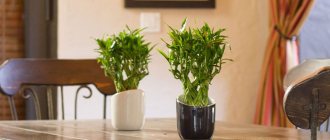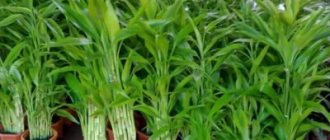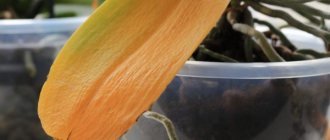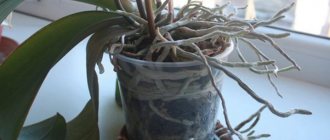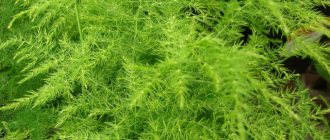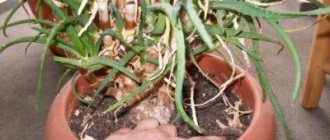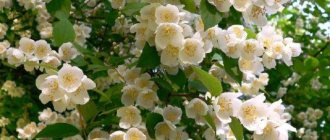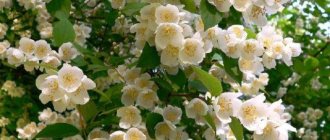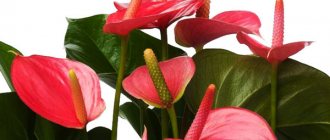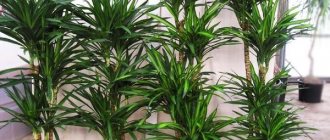Dracaena leaves turn yellow and fall off: what could be the reasons?
Dracaena gives any interior an exotic look. It is also called palm or false palm. Yellowing of leaves can be caused by a number of reasons. There are cases when even the most experienced gardeners cannot understand why dracaena leaves turn yellow and how to help it. And sometimes even if you take proper care, it is not enough.
Various reasons lead to yellowing of foliage
The most common reasons for the appearance of yellow leaves in dracaena:
- natural aging. The lower leaves of the flower turn yellow and die, and this is a normal process. If the stem is tall and elongated, the main trunk should be cut off to allow new stems to grow and tillering to increase;
- excess moisture. Too much moisture is another cause of yellowing leaves. Waterlogged soil and lack of drainage provoke root rot, which leads to weakened immunity and the development of diseases, the symptoms of which can be determined by the condition of the leaves. By watering once a week, you can improve the condition and color of the leaves;
- lack of humidity. This factor also affects the condition of the flower and causes the dracaena to appear yellow leaves. Tropical plants grow well in conditions of high humidity; dry air in city apartments is contraindicated for them. The plant should be regularly sprayed and moistened, especially in winter, when the air in homes is too dry. You can place containers filled with water next to the pot to increase the humidity in the room;
- direct sunlight. They are harmful to the leaves as they cause them to turn yellow. It is important to choose the right place where the flower will stand. Dracaena should always be protected from the sun;
- lack of light. In low light, the plant turns yellow, starting from the lower leaves, then the leaves fall off. Sometimes the leaf blade turns yellow when one side is in the shade. Therefore, the flower should be rotated periodically to ensure even exposure to light;
- viral infection. If the plant is infected with a virus, the first symptom will be yellow foliage. The leaf blade and stem are also deformed. The infection is contagious, so it can spread to neighboring indoor flowers;
- pests Spider mites, thrips, and scale cause yellowing of the leaves and the appearance of additional symptoms, such as brown spots on the stems, grayish plaques on the leaves, or thin whitish marks. Pests suck out the cell sap, so the leaves turn yellow and fall off.
Finding out why the leaves began to turn yellow is not so difficult. You should analyze the care of the flower and correct errors.
Note! Yellowing of the lower leaves is a normal natural phenomenon for a houseplant. In order for new foliage to appear, the flower needs to get rid of the old one. But if yellowing occurs en masse, this most often indicates the development of the disease.
Why do the leaves of a home palm tree dry out?
Domestic palm trees have long come to our homes from southern latitudes, from hot countries. Today, these southern beauties are used with great success for landscaping a wide variety of rooms. But sometimes you can see that the tips of the palm leaves turn yellow, or even the entire leaf dries out and falls off. Why this happens and whether it is possible to avoid such troubles when growing palm trees at home is a question that concerns many lovers of this beautiful exotic plant.
The main reason for the drying of domestic palm leaves is improper care and maintenance. There are several possible reasons for this.
The most common mistake in caring for indoor palm trees is too dry indoor air and insufficient watering. The leaves can also be damaged by various parasites and diseases. The palm tree may die completely if it is already very old, or its roots have begun to rot from excessive overwatering. In addition, we must take into account that the palm tree is a southern plant and needs good lighting. Therefore, the room for comfortable growth of the plant must be chosen as bright and high enough as possible.
The main reason for the drying of domestic palm leaves is improper care and maintenance. There are several possible reasons for this.
The appearance of pests
Yellowing of the leaves of a palm tree when grown in an apartment also occurs due to the invasion of parasitic individuals. It is attacked mainly by spider mites, scale insects, and mealybugs. These pests feed on green matter and quickly invade new territories. Most often, individuals with weakened immune systems are susceptible to infection.
Insecticidal preparations such as Fitoverm, Actellik, and Confidor work effectively against parasites on palm trees. The working fluid is prepared taking into account the manufacturer's instructions; the recommended number of sprays is 3-4 times, but with an interval of 5 days. For serious lesions, the use of a highly concentrated solution is allowed, where the dosage is increased by 2-3 times. In addition, do not forget about the additional spillage of soil.
Drying leaves on a palm tree may indicate root rot, which can easily destroy it in a short time. You can try to save the plant from such a dangerous disease by replanting it in another soil, but first you need to remove the affected areas of the root system and treat them with crushed coal.
If the reason for the drying of the palm tree is problems with the root system, then they need to be solved and the condition of the soil substrate must be monitored in the future. Neither overwatering nor drying out of the soil should be allowed. It is recommended to use only sharp and disinfected instruments to remove diseased roots. In most cases, replanting saves the plants.
Spraying plants
- In a heated room, spray the leaves of green plants every morning. It doesn't take much time but brings wonderful results. A gentle shower refreshes the plants, allowing their cells to work at full capacity, and in addition increases the humidity in the room. Tip
: For spraying, boil water in a large saucepan and keep it in reserve in large plastic bottles.
Here's what to do if the tips of the leaves of a palm tree dry out:
Ventilation
On a frosty day, do not open the windows wide in the room with plants. Please also note that in most cases frosty air is dry. Therefore, ventilation does not increase the humidity in the room. It is best to ventilate more often, but little by little.
Tip : At temperatures around 0 °C, it is enough to open the windows for 10 minutes every 2-3 hours.
Optimal temperature values: in the living room 20 °C, in the kitchen and bedroom 16-18 °C.
Tip : If possible, regulate the temperature in the house not by ventilation, but by using a thermostat.
Large Licuala palm (Licuala grandis). © wkfplants Elegant Chamaedorea palm (Chamaedorea elegans). © wkfplants Yellowish Dipsis (Dypsis lutescens)
Ventilation
On a frosty day, do not open the windows wide in the room with plants. Please also note that in most cases frosty air is dry. Therefore, ventilation does not increase the humidity in the room. It is best to ventilate more often, but little by little.
Tip : At temperatures around 0 °C, it is enough to open the windows for 10 minutes every 2-3 hours.
Optimal temperature values: in the living room 20 °C, in the kitchen and bedroom 16-18 °C.
Tip : If possible, regulate the temperature in the house not by ventilation, but by using a thermostat.
Large Licuala palm (Licuala grandis). © wkfplants Elegant Chamaedorea palm (Chamaedorea elegans). © wkfplants Yellowish Dipsis (Dypsis lutescens)
How to care for Areca palm at home
In well-lit places, the Areca palm is a fairly unpretentious plant. The main thing in caring for Chrysolidocarpus at home is maintaining watering schedules and maintaining sufficient air humidity. In summer everything is quite simple, but in winter it is necessary to reduce watering to a minimum and spray the palm tree more often.
Areca requires good lighting both in summer and winter. It is advisable to place it near southern windows, but direct sunlight can leave burns on the leaves, so shade Areca in the summer with curtains. With excessive light, the leaves lose their color and become yellowish.
Why does this happen, what to do and how to save it?
A favorite of many gardeners, it is considered an unpretentious plant for home cultivation. However, almost all owners of dracaenas experience drying of the leaves. Most often this happens for natural reasons, since the lifespan of one leaf is 1.5-2 years. After this, it begins to gradually turn yellow and dry.
This usually applies to the most mature lower leaves. There is nothing dangerous about this. To preserve decorativeness, the tips of such leaves are trimmed to healthy tissue.
Drying young leaves raise doubts about the correct care. The reason for this may be:
- incorrect air humidity;
- poor watering;
- incorrect location;
- presence of pests or diseases;
- low air temperature;
- bad light;
- lack of fertilizing.
To help the plant in a timely and correct manner, you need to figure out which of the reasons is destroying it.
Drying young leaves raise doubts about the correct care. The reason for this may be:
Although most indoor palms are true tropical plants, they do not tolerate heat well, especially if high temperatures are accompanied by low indoor humidity.
The risk of leaves drying out at the tips increases significantly during the heating season, when currents of hot air rise from the radiators.
In addition to these factors, a palm tree can dry leaves in the following situations:
- Temperature changes or exposure to drafts;
- Frequent transplants unnecessarily;
- Improper watering (severe drying out or waterlogging of the earthen clod);
- Mineral fasting;
- Impact of pests and consequences of diseases.
Keeping the palm tree in a suitable microclimate and normalizing care solves the problem of drying leaves.
Important: if you find dried leaves on a palm tree, do not panic - often the lower tier dies off on its own as the crown grows.
Low air humidity: what to do?
Dry air not only does not add beauty to a home palm tree, but also affects its health, reducing resistance to pests and diseases.
That is why the primary task is to normalize humidity, which can be achieved in several ways:
- Spray the leaves daily with a spray bottle. You need to use warm, settled water, dispersing it with a fine spray.
- Install special devices. An electric humidifier is an ideal solution during the heating season.
- Create natural hydration. Several pots with plants, bowls with expanded clay, filled with water, release moisture, maintaining an optimal microclimate.
Additionally, you can cover the batteries with a wet towel if the pot with a palm tree is on a windowsill or near a window.
Ventilate the room periodically if the outside temperature rises above zero. Bathing in a warm shower will also benefit the plant and improve the condition of the foliage.
Unsuitable temperature and drafts
Winter maintenance of a home palm tree should be given special attention, since it is during the cold months that the plant is at rest, accumulating strength for future active growth.
“Equatorial” indoor temperatures are the worst thing you can do to a palm tree during its resting period. The heat causes the leaves to dry out, the crop loses its attractive appearance and subsequently takes a long time to recover.
The temperature in the room must be maintained depending on the type:
- +8-+12 degrees – for Washingtonia, trachycarpus and brachea;
- about +24 – for the Robelena date, chamedorea and areca;
- +16 degrees – for rapis, rapalostilis and sabal.
Without ventilation, palm tree leaves dry out at the tips, and drafts harm the crown. Maintain a balance - take the pot out of the room when you open the window so that the green mass is not damaged by cold air flows.
Frequent transfers
Improper replanting is the reason why palm leaves may turn yellow and dry at the tips. It is necessary to transfer the plant into a new pot only after the earthen clod has been completely developed, so that the sensitive root system is not injured.
Young specimens need to be replanted once a year, adult palm trees - every 2-3 years. Large trees in massive tubs are not touched, but only the top layer of soil is replaced with fresh soil and fed regularly.
An unscheduled transplant is justified only if the palm tree is sick and needs to resuscitate the root system or completely replace the soil.
Similar situations arise when there is an invasion of pests, the development of root rot and severe waterlogging of the soil in the pot.
Improper watering
Lack of moisture in the soil inevitably affects the green mass of the palm tree, causing the tips to dry out. Excessive watering is fraught with similar external consequences, but the root system suffers more in such a situation.
A dried palm tree can be watered, but a plant that has suffered from waterlogging requires serious measures.
Simple recommendations will help you avoid mistakes in watering:
- Moisten the soil in the pot only after the top layer (2-3 cm) has dried.
- Use warm or room temperature water, allowing it to sit for several days until sediment forms and the chlorine evaporates.
- Drain off any liquid that remains in the pan half an hour after watering.
- In winter, moisten the substrate less often than in summer, since moisture evaporates more slowly in cool conditions.
A home palm tree needs a high-quality drainage system that prevents moisture from stagnating around the roots. Make sure that there are special holes at the bottom of the pot, and before each transplant, lay a layer of expanded clay before filling the soil.
It is not recommended to water a dry indoor palm tree with a “shock” portion of water - this will lead to breakage of the roots and subsequently affect the ability to absorb nutrients. It is better to solder the tree gradually, slightly moistening the substrate every couple of hours.
If the palm tree begins to dry out its leaves due to severe waterlogging of the soil, it is better to immediately replant it in fresh, light soil.
Carefully remove the plant from the container, remove all waterlogged substrate and inspect the roots, removing any rotten or dead areas.
The cut areas must be sprinkled with crushed charcoal, which will prevent further spread of rot. After transplantation, moderate watering is recommended, while it is better to keep the palm tree in light partial shade for 2-3 days.
Mineral fasting: why is it important to feed?
Iron, nitrogen, potassium, phosphorus and other microelements are important components of the complete nutrition of a palm tree. If they are deficient, the condition of the green mass deteriorates, the tips dry out, and the plant loses its decorative properties.
To prevent mineral starvation, it is enough to regularly apply special fertilizers for palm trees or compositions for decorative foliage indoor flowers.
The optimal frequency is once every 10-14 days during the active growing season (from spring to early autumn). Be sure to follow the dosage to avoid overfeeding.
It is necessary to fertilize the palm tree only in moist soil so that the root system does not suffer from burns.
Pests and diseases
Most often, palm trees are affected by scale insects, spider mites and mealybugs, which feed on the leaves and gradually spread throughout the plant.
Improper care significantly increases the likelihood of infection, since a specimen with a weakened immune system is unable to resist insects.
Insecticides “Fitoverm”, “Confidor”, “Aktellik” and their analogs show high efficiency in the fight against these pests.
Spraying the crown is carried out with a solution prepared according to the instructions on the package, the optimal number of treatments is 3-4 every 5 days.
In the presence of large colonies of insects, a highly concentrated dose of the drug is used (2-3 times more than recommended) and an additional spill of soil.
The leaves of a domestic palm tree can dry out and turn black as root rot spreads, which first disrupts the nutrition of the plant and then provokes its complete death.
At the initial stage of the disease, the palm tree can be saved through unscheduled replanting and normalization of agricultural practices.
Diseases
Why do dracaena leaves fall off - reasons
The cause may be too dry air, too low a temperature or sudden changes in the environment. If you move a dracaena, for example, from a cool street to a warm apartment, this can lead to cracking of the edges of its leaves. In addition, you should not expose the plant to temperature fluctuations. Yellowing of the leaf blade is guaranteed.
One of the symptoms of the disease is yellow leaves
Dracaena diseases can also occur as a result of excessive sun exposure, which leads to burns on the leaves. In turn, too little light can lead to fading and weaker colors found in some varieties. Slowing growth, transparency of leaves, as well as their yellowing and falling off are possible consequences of improper propagation of dracaena.
Most often, the flower is affected by infectious diseases. They are transmitted from neighboring plants and brought in with tools while loosening the soil. If you ignore the yellowing of the foliage and do not take action, the dracaena will soon die.
Important! The infection can be brought into the house with other indoor plants from a store or market, as well as with untreated garden tools.
Bacterial infection
A bacterial infection on dracaena appears as dark brown, rapidly growing spots on the tips of the leaves. Sometimes the stem also turns black at the base and the rot moves to the petioles. The result may be an unpleasant odor. For mild infections, remove diseased leaves and spray the plant and substrate with a growth stimulant, which reduces the development of spot disease. Unfortunately, once the disease is advanced, it is no longer possible to save the plant.
Bacteria attack leaf tips
Fungal infection
May have a bacterial or fungal basis. Yellow, brown, irregular spots ranging in size from 1 to 5 mm with a red border appear on the leaves of dracaena. On top of them are black clusters of fungal spores. It is important to remove the affected leaves and stop spraying the plant. To preserve dracaena, a series of biological products and fungicides should be used.
Fungal disease
Note! To prevent fusarium spotting, you need to take the same preventive measures. With this disease, rotting of the leaf rosettes is observed, and small watery spots with a light yellow border appear on the leaf blades.
Mold in the soil
Mold in the soil damages most houseplants. Its appearance is promoted by poor soil quality, lack of light, high air and soil humidity, and excessive watering. If mold is detected in the spring, it would be advisable to transplant the plant into fresh soil with a loose substrate, preferably with a drainage layer.
This is what mold in the soil looks like
What to do if there are errors in care?
Do not panic if the lower leaves begin to dry out slightly. This is normal and in the process of growth new green ones will grow, but the dracaena wants to shed the old ones and will gradually shed them.
The lower old leaves are falling off - this is not a cause for concern
If young leaves begin to turn yellow and fall off , then the reasons are:
- low air humidity
- sudden drop in room temperature
- installing a flowerpot in a draft
- overwatering
- pest damage that can cause leaves to fall off.
Errors need to be fixed:
- equip with a new substrate of pebbles, moss, expanded clay
- spray the plant only with settled water 2 times a week
- do not allow installation in cold or drafty conditions, since dracaena reacts painfully to changes in maintenance conditions and sudden temperature fluctuations
- do not allow the soil to become waterlogged , which will lead to rotting of the root system
- do not feed dracaena with fertilizers more than 3 times a year
- replant the plant if the pot becomes small and the overgrown roots begin to extend beyond the drainage holes.
The roots have grown very much - the dracaena needs to be replanted.
Only stable conditions are acceptable for the dracaena. As a result, care will lead to the growth of a healthy plant with shaggy flowers.
Lack of normal nutrition will lead to depletion of the plant and loss of leaves. So soon the dracaena may die completely. The best thing is to quickly replant the flower, equipping it with the necessary minerals and trace elements, new and fresh soil.
Pests
Why Dieffenbachia leaves turn yellow - reasons
Failure to follow the rules of care leads to parasites attacking the dracaena. Sucking the juices from the leaves leads to the slow death of the flower.
Pests can destroy a flower overnight
Dracaena pests:
- thrips. This is the most dangerous parasite that attacks indoor plants. Its length is only 1.5 mm. Pests, settling on the foliage from below, begin to actively suck out the cell sap. The females gnaw through the tissue, causing the leaf blade to turn yellow. As a result, the foliage dries out and falls off. High room temperature leads to their rapid reproduction. To save the flower, dracaena leaves are sprayed with a soap solution and covered with a plastic bag. A sticky trap also reduces the number of pests. In addition, drugs such as spark, fitoverm help;
- Mealybugs. This insect can be seen with the naked eye. On top it is covered with a white waxy coating. Females and larvae suck the juice from the cells, disrupting the development of the flower. Moving quickly, they leave behind a whitish coating. Using a toothbrush dipped in soapy water, you can remove waxy traces of parasites. Akhtar, fitoverm or calypso will help save dracaena in case of severe damage;
- scale insect A common parasite among indoor plants. This arachnid is covered on top with a protective shield. The female lays a huge number of larvae, which, like adults, are covered with scutes. They are securely attached to the foliage and suck the juice from it. Dracaena stops developing, turns yellow, dries out and dies. Treatment is carried out using a sponge and methyl alcohol (very carefully). Once weakened, the pests are destroyed with drugs such as Inta-SM or Actara. Yellow leaves of the plant must be removed.
Important! After treating the plant with chemicals, it is necessary to replace the top layer of the substrate.
What to do if the stem turns yellow
If a flower's stem begins to turn yellow, it is necessary to provide proper care to save the plant. To do this, take a sharp thin knife and cut off the yellowed part.
Note! When pruning is not done in a timely manner, yellowness begins to consume the entire plant.
The end result is that the flower dies and cannot be saved. The resulting cut is left on a soft cloth or piece of paper to dry. The cut area must be treated.
For disinfection, ground charcoal or charcoal powder, which is sold in flower shops, is used.
After processing, the cut is left to lie for another 4 hours. Next, the remaining coal that has not been absorbed into the stem is carefully removed.
The cut must be handled carefully so as not to damage the wound of the indoor plant. Soft wax is applied on top. It should not be hot, otherwise the plant will get burned and may die.
Soil moisture
Why do geranium leaves turn yellow at home - causes and treatment
Dracaena is a plant that came to Russia from countries where drought alternates with heavy rains. This led to the fact that the plant acquired special properties that make the flower resistant to irregular watering. However, these changes that nature gave to the flower become a huge disadvantage when the plant is in a constantly humid environment.
Proper watering will be a good preventative against yellowing of foliage.
The best way to water this plant is by immersion method:
- Partially fill a sink or large container with water.
- Place the pot. The water should reach the level of the soil in the pot.
- Soak the pot of dracaena in water for 7-10 minutes.
- Lift the pot and place it on a wire rack to allow any excess water to drain.
- When the dripping has stopped, return the plant to its place.
You can water the next time only when the soil is completely dry. To check, you should deepen your finger 5-8 cm. It should be dusty and dry. If there is even a little moisture left, there is no need to water. It is important to periodically loosen the substrate. This will saturate it with oxygen and become a good preventative against diseases.
Note! Experienced gardeners assure that dracaena needs to be watered every 5-7 days.
In winter, dracaena is dormant. At this time, the same rules as above apply, except that it may take up to a month for the soil to dry out from the previous watering. You can water every 15-30 days. There is no need to moisten the soil weekly.
Bamboo turns yellow in water or hydrogel
Bamboo can be grown not only in the traditional way - in soil, but also in water and in modern hydrogel. Note that when grown in this way, the leaves of the plant turn yellow less often, but it still happens. Let's get acquainted with the probable causes of the problem in this case.
Water quality
This is the most likely cause of yellowing. The worst option is chlorinated water: avoid growing bamboo in it. In addition, it is important that the mineralization of the species is not too high. Set aside tap water or use purchased distilled water.
Too much fertilizer
When growing dracaena in water or hydrogel, many gardeners find it difficult to navigate the amount and frequency of fertilizing. We recommend fertilizing no more than once every six months.
Sun
Do not keep the plant in direct sun: unsightly burn spots may remain on the leaves.
Drafts
Indoor bamboo, growing in liquid, is very sensitive to coolness. It is extremely undesirable to expose it to cold wind and drafts.
If no measures help and the plant continues to turn yellow, it is recommended to replant it in the ground and continue to grow it in the soil.
Root rotting
The fact that the leaves have begun to turn yellow may indicate that the roots have begun to rot due to excess moisture.
Rotted dracaena roots
How to understand that the soil is waterlogged:
- damp, undried soil smells of dampness and mold;
- Having buried your finger 2 cm, you can feel that the soil is damp;
- when using mulch, it signals an excess of moisture by turning black;
- There will be stagnation of water in the container under the pot.
Important! A drainage layer in a pot with dracaena will allow you to control comfortable soil moisture. During replanting, a new layer should be used.
Other Possible Problems
Most often, the leaves of a houseplant turn yellow due to improper watering or excess sunlight. But there are also others that novice gardeners may not be aware of.
Among them:
- cold and drafts have a negative effect on tropical plants. Dracaenas do not like to grow near air conditioning, ventilation holes and open windows, and every movement of air masses is immediately reflected in the appearance of the plants: yellow leaves or pale spots appear between the veins. It is better to place an indoor flower at home in a quiet place;
- transfer. In order for the flower to grow well and have abundant foliage, it must be replanted periodically. If the plant's leaves begin to turn yellow, become spotted, or fall off, it's time to change the pot and soil. Usually, when dracaena grows for more than three years in the same substrate, it grows poorly. The thing is that a huge amount of salts begin to accumulate in the old soil, which prevent the flow of nutrients to the above-ground part. In order for the flower to feel good, it is recommended to replant every two years (in spring). For looseness, add a little sand or charcoal to the soil mixture. In addition, it is necessary to replace the top layer of soil with a new one every year;
- nutritional deficiency. If yellow leaves begin to appear at the top of the plant, this symptom is likely due to nutrients in the soil. This is caused by too much calcium in hard water or too little nitrogen in the soil. This problem can be solved by using nitrogen fertilizers or replacing irrigation water;
- excess nitrogen fertilizers. Irrational use of fertilizers leads to leaves falling off, sometimes they do not even have time to turn yellow.
Dracaena is a beautiful and beloved indoor plant. With proper care, it delights with its abundant bright green foliage. The flower begins to shed its leaves after two years. These are natural processes. Yellowing of the leaf blade also does not always indicate developmental disorders or the presence of diseases. Old foliage on the lower tiers should turn yellow and then fall off. But excessive yellowing, falling off and additional symptoms should alert you. After finding out the cause and working on the errors, the plant will begin to grow with renewed vigor.
Is it easy to treat dracaena at home?
Dracaena is an exotic but unpretentious plant. With proper care it will become a real decoration in the corner of a room or office. The shaggy tops are attractive, and in appearance, due to the shape of the crown and leaves, the plant is very similar to a dragon.
The flower tolerates shade and does not require special care skills. However, a luxurious and fluffy dracaena will delight the eye only when all the rules of care and cultivation at home are followed, and all measures to combat diseases at the initial stage are taken in a timely manner.
Treating dracaena is not difficult if done in a timely manner. It is best to carry out preventive measures to combat diseases and not neglect the conditions of the plant. If yellow spots appear on the leaves, the edges dry out, or the upper part of the root system is damaged, it is better to replant immediately.
Particularly dangerous is the fungus that can reside in the substrate. It is necessary to replace the soil and add charcoal.
The basics of prevention are maintaining temperature, humidity conditions and eliminating drafts. Experienced flower growers advise creating conditions so that the dracaena blooms, smells fragrant and delights the eyes of others for many years with its luxurious beautiful flowers.
